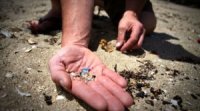- Home
- Endorsements
- Scorecard
- News
- Take Action
- Support CLCV
- About CLCV
- About CLCV
- CLCV Board of Directors
- Green Advisory Council
- CLCV Staff
- Contact CLCV
- Jobs at CLCV
- CLCV Education Fund
- Issues
- Air Quality
- Clean & Renewable Energy
- Environmental Justice
- Global Warming
- Good Government
- Green Jobs
- Ocean / Coastal Protection
- Oil & Gas
- Open Space & Parks
- Recycling / Waste Reduction
- Smart Growth, Land Use & Planning
- Toxics & Chemicals
- Transportation
- Water Quality & Supply
- Wildlife & Habitat Conservation
- Local Leagues
- Donate
Why are we flushing plastic down the drain?

Washing your face and brushing your teeth are daily activities that shouldn’t cause harm to our environment. Unfortunately, tiny plastic beads in some personal care products are entering our local streams and rivers directly from our sinks – and they're eventually found in the ocean and inside the bodies of marine wildlife.
Products with microbeads are everywhere. Even opening my own bathroom cabinet earlier this week, I found that my “natural daily brightening scrub” contained micro-plastic. Despite my awareness of this issue, products with microbeads are so common that they're nearly unavoidable.
Here's the problem: Exfoliating ingredients in many products like facial and body scrubs and toothpaste are actually made out of tiny particles of plastic. They wash down the drain, flowing into the sewage system, into watersheds and, eventually, our oceans. Because of their size it’s nearly impossible for sewage and other water treatment facilities to stop these tiny invaders from getting into local waterways.
A single product like my tube of face scub can contain as much as 350,000 polyethylene or polypropylene “microbeads.” Microbeads are now a significant part of the debris accumulating in the Pacific Ocean and are also found at alarming levels in our local waterways.
It’s well known that plastic trash is bad news for our environment – it pollutes our urban and marine environments and when it breaks down, it’s deadly for the wild creatures that call our oceans home. That’s why we’ve been working for years to support a phase-out of single-use plastic bags in California (SB 270). But plastic exfoliating beads are so small, they don't even need to break down in order to end up in the stomachs of marine life.
Mircobeads are not biodegradable and absorb various toxins such as DDT, PCBs (flame retardants), and other industrial chemicals. They are ingested or absorbed by a variety of marine life and other mammals. Scientists are also concerned about the impacts on humans who eat fish that have ingested or absorbed plastic pollution further tainted with toxic chemicals. Studies have shown that these microbeads are prevalent in ocean debris piles, the Great Lakes, and even the Los Angeles River.
(Learn more about the seriousness of this problem on the 5 Gyres website.)
There’s zero reason for companies to continue using these environmentally hazardous microbeads when there are plenty of safer and biodegradable alternatives available such as walnut husks, pecan shells, apricot shells, and cocoa beans.
So why are producers of personal care products fighting a common-sense bill to phase out microbeads in these products in California by 2019? Maybe because they’re afraid that what happens in California will set a precedent and have a ripple effect nationally.
That’s what we’re hoping for, too! Stay tuned; AB 1699 passed the Assembly in May and the vote is expected on the Senate floor soon.
Tags:

